Duiker W.J., Spielvogel J.J. The Essential World History. Volume 2: Since 1500
Подождите немного. Документ загружается.


especially among the millions of
Americans who still had relatives liv-
ing in Eastern Europe. Winston
Churchill was quick to put such fears
into words. In a highly publicized
speech at Westminster College in Ful-
ton, Missouri, in March 1946, the
former British prime minister declared
that an ‘‘iron curtain’’ had ‘‘descended
across the Continent,’’ dividing Ger-
many and Europe itself into two hos-
tile camps. Stalin responded by
branding Churchill’s speech a ‘‘call to
war with the Soviet Union.’’ But he
need not have worried. Although
public opinion in the United States placed increasing
pressure on Roosevelt’s successor, Harry Truman (1884--
1972), to devise an effective strategy to counter Soviet
advances abroad, the American people were in no mood
for another war.
The first threat of a U.S.-Soviet confrontation
took p lace in the Middle East. During World War II,
British and Soviet troops had been
stationed in Iran to prevent Axis
occupation of the rich oil fields in
that country. Both nations had
promised to w ithdraw their forces
after the war, but at the end of 1945,
there were ominous signs that
Moscow might attempt to use its
troops as a bargaining chip to annex
Iran ’s northern territories---known
as Azerbaijan---into the Soviet
Union. When the government of
Iran,withstrongU.S.support,
threatened to take the issue to the
United Nations, the Soviets backed
down and removed their forces from that country in
the spring of 1946.
The Truman Doctrine
A civil war in Greece created another potential arena for
confrontation between the superpowers and an opportunity
for the Truman administration to take a stand. Communist
guerrilla forces supported by Tito ’s Yugoslavia had taken up
arms against the pro-Western government in Athens. Great
Britain had initially assumed primary responsibility for
promoting postwar rec onstruction in the eastern M editer -
ranean, but in 1947, continuing economic problems caused
the British to withdraw from the active role they had been
playing in both Greece and Turkey. Pres ident Truman,
alarmed by British weakness and the possibility of Soviet
expansion into the eastern Mediterranean, responded with
the Truman Doctrine, which said in essence that the U nited
States would provide money to countries that claimed they
were threatened by Communist expansion. If the Soviets
were not stopped in Greece, the Truman argument ran, then
the Uni ted States would have to face the spread of com-
munism throughout the free world. As Dean A c heson, the
U.S. secretary of state, explained, ‘‘Like apples in a barr el
infected by disease, the corruption of Greece would infect
Iran and all the East...likewise Africa ...Italy ...France. ...
Not since Rome and Carthage has there been such a po-
larization of power on this earth.’’
2
The U.S. suspicion that Moscow was actively sup-
porting the insurgent movement in Greece turned out to
be unfounded. Stalin was apparently unhappy with Tito’s
promoting the conflict, not only because he suspected
that the latter was attempting to create his own sphere of
influence in the Balkans but also because it risked pro-
voking a direct confrontation with the United States. But
the Truman Doctrine had its intended effect in the
United States, where public concern about the future
intentions of the Soviet Union rose to new heights.
Corsica
Sardinia
D
a
n
u
b
e
C
Z
E
C
H
O
S
L
O
V
A
K
IA
GER.
DEM.
REP.
WEST
GER.
Y
U
G
O
S
L
A
V
I
A
SOVIET
UNION
R.
BULGARIA
ROMANIA
ITALY
ALBANIA
HUNGARY
GREECE
AUSTRIA
POLAND
Baltic Sea
0 150 Miles
0 300 Kilometers
Eastern Europe in 1948
A Call to Ar ms. Within five years of the end of World War II, the
Grand Alliance that had brought victory over the Axis Powers was in
tatters. In March 1946, former British Prime Minister Winston Churchill,
in an address given at Westminster College in Fulton, Missouri, declared
that Soviet occupation of Eastern Europe had divided the Continent into
two conflicting halves, separated by an ‘‘iron curtain.’’ The speech is often
credited with launching the first salvo in the Cold War.
AP Images
646 CHAPTER 26 EAST AND WEST IN THE GRIP OF THE COLD WAR
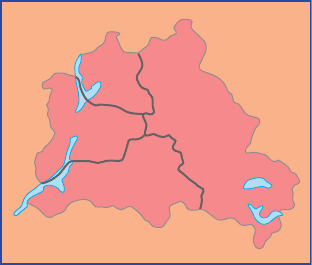
The Marshall Plan
The proclamation of the Truman
Doctrine was followed in June 1947 by
the European Recovery Program, bet-
ter known as the Marshall Plan, which
provided $13 billion for the economic
recovery of war-torn Europe. Under-
lying the program was the belief that
Communist aggression fed off eco-
nomic turmoil. As General George
C. Marshall observed in a speech at
Harvard University, ‘‘Our policy is not
directed against any country or doctrine but against
hunger, poverty, desperation, and chaos.’’
3
From the Soviet perspective, the Marshall Plan was
capitalist imperialism, a thinly veiled attempt to buy the
support of the smaller European countries ‘‘in return for
the relinquishing ...of their economic and later also their
political independence.’’
4
A Soviet spokesperson described
the United States as the ‘‘main force in the imperialist
camp,’’ whose ultimate goal was ‘‘the strengthening of
imperialism, preparation for a new imperialist war, a
struggle against socialism and democracy, and the sup-
port of reactionary and antidemocratic, pro-fascist re-
gimes and movements.’’ Although the Marshall Plan was
open to the Soviet Union and its Eastern European sat-
ellite states, they refused to participate. The Soviets were
in no position to compete financially with the United
States, however, and could do little to counter the Mar-
shall Plan except tighten their control in Eastern Europe.
Europe Divided
By 1947, the split in Eur ope between East and West had
become a fact of life. At the end of World War II, the
U nited States had favor ed a quick end to its commitments
in Eur ope. But American fears of Soviet aims caused the
U nited States to play an increasingly important role in
Eu ropean affairs. In an article in Foreign Affairs in
J uly 1947, George K ennan, a well-known U.S. diplomat
with much knowledge of Soviet affairs, advocated a policy
of containment against further aggressive Soviet moves.
Kennan favored the ‘‘adroit and vigilant application of
counter -for ce at a series of constantly shifting geographical
and political points, corresponding to the shifts and ma-
neuvers of Soviet policy.’’ When the Soviets blockaded
Berlin in 1948, containment of the Soviet U nion became
formal U.S. policy (see the box on p . 648).
The Berlin Blockade The fate of Germany had become
a source of heated contention between East and West.
Aside from denazification and th e partitioning of
Germany (and Berlin) into four oc-
cupied zones, the Allied powers had
agreed on little with rega rd to the
conquered nation. Even dena zifica-
tion proceeded differently in the
various zones of occupation. The
Americans and British proceeded
methodically---the British had tried
two million cases by 1948---while the
Soviets (and French) went after ma-
jor criminals and allowed lesser offi-
cials to go free . The Soviet Union,
hardest hit by the war, took repar-
ations from Germany by pillaging German industr y. The
technology-starved Soviet s dismantled an d removed to
Russia 380 factories from the western zones of Be rlin
before transferring their control to the Western powers.
By the summer of 1946, two hundred chemical, paper,
and textile factories in the East German zone had like-
wise been shipped to the Soviet Union. At the same
time, the German Communist Party was reestablished,
under the control of Walter Ulbricht (1893--1973), and
was soon in charge of the political reconstruction of the
Soviet zone in eastern Germany.
Although the foreign ministers of the four occupying
powers kept meeting in an attempt to arrive at a final
peace treaty with Germany, they moved further and fur-
ther apart. At the same time, the British, French, and
Americans gradually began to merge their zones eco-
nomically and by February 1948 were making plans for
unification of these sectors and the formation of a na-
tional government. In an effort to secure all of Berlin and
to halt the creation of a West German government, the
Soviet Union imposed a blockade of West Berlin that
prevented all traffic from entering the city’s western zones
through Soviet-controlled territory in East Germany.
The Western powers faced a dilemma. Direct military
confrontation seemed dangerous, and no one wished to
risk World War III. Therefore, an attempt to break through
the blockade with tanks and trucks was ruled out. The
solution was to deliver supplies for the city’ s inhabitants by
plane. At its peak, the Berlin Airlift flew 13,000 tons of
supplies daily into Berlin. The Soviets, also not wanting
war, did not interfere and finally lifted the blockade in
May 1949. The blockade of Berlin had severely increased
tensions between the United States and the Soviet U nion
and brought the separation of Germany into two states.
The Federal Republic of German y was formally created
from the three Western zones in September 1949, and a
month later , the separate German Democratic R epublic
(GDR) was established in East Germany. Berlin remained a
divided city and the source of much contention between
East and West.
FRENCH
ZONE
BRITISH
ZONE
U.S. ZONE
SOVIET
ZONE
EAST GERMANY
Berlin at the Start of the Cold War
THE COLLAPSE OF THE GRAND ALLIANCE 647

NATO and the Warsaw Pact The search for security in
the new world of the Cold War also led to the formation
of military alliances. The North Atlantic Treaty Organi-
zation (NATO) was formed in April 1949 when Belgium,
Denmark, France, Great Britain, Iceland, Italy, Luxem-
bourg, the Netherlands, Norway, and Portugal signed a
treaty with the United States and Canada. All the powers
agreed to provide mutual assistance if any one of them
was attacked. A few years later, Greece, Turkey, and West
Germany joined NATO.
The Eastern European states soon followed suit. In
1949, they formed the Council for Mutual Economic
OPPOSING VIEWPOINTS
W
HO STARTED THE COLD WAR?AMERICAN AND SOVIET PERSPECTIVES
AlthoughtheUnitedStatesandtheSovietUnion
had cooperated during World War II to defeat the
Germans and Japanese, differences began to ap-
pear as soon as victory became certain. The year
1946 was an especially important turning point in the relation-
ship between the two new superpowers. George Kennan, an
American diplomat regarded as an expert on Soviet affairs, was
asked to write an analysis of one of Stalin’s speeches. His U.S.
Foreign Service dispatch, which came to be known as the Long
Telegram, was sent to U.S. embassies, U.S. State Department
officials, and military leaders. The Long Telegram gave a highly
critical view of Soviet intentions. A response to Kennan’s position
was written by Nikolai Novikov, a former Soviet ambassador to
the United States. His response was read by Vyacheslav Molotov,
the Soviet foreign minister, but historians are not sure if Stalin or
other officials also read it and were influenced by it.
George Kennan, The Long Telegram, February 1946
At the bottom of [the Soviet] neurotic view of world affairs is a tra-
ditional and instinctive Russian sense of insecurity. Originally, this
was the insecurity of a peaceful agricultural people trying to live on
a vast exposed plain in the neighborhood of fierce nomadic peoples.
To this was added, as Russia came into contact with the economi-
cally advanced West, the fear of more competent, more powerful,
more highly organized societies. ... For this reason [the Russians]
have always feared foreign penetration, feared direct contact between
the Western world and their own. ... And they have learned to seek
security only in patient but deadly struggle for total destruction of
rival power, never in compacts and compromises with it. ...
In summary, we have here a political force committed fanati-
cally to the belief that with the United States there can be no per-
manent modus vivendi, that it is desirable and necessary [that] the
internal harmony of our society be disrupted, our traditional way of
life be destroyed, the international authority of our state be broken,
if Soviet power is to be secure. ... In addition it has an elaborate
and far-flung apparatus for exertion of its influence in other coun-
tries, an apparatus of amazing flexibility and versatility, managed by
people whose experience and skill in underground methods are pre-
sumably without parallel in history. Finally, it is seemingly inaccessi-
ble to considerations of reality in its basic reactions. ... This is
admittedly not a pleasant picture. ... But I would like to record my
conviction that the problem is within our power to solve---and that
without recourse to any general conflict. ... I think we may ap-
proach calmly and with good heart the problem of how to deal with
Russia ...[but] we must have the courage and self-confidence to
cling to our own methods and conceptions of human society. After
all, the greatest danger that can befall us in coping with this prob-
lem of Soviet communism is that we shall allow ourselves to become
like those with whom we are coping.
Nikolai Novikov, Telegram, September 27, 1946
One of the stages in the achievement of dominance over the world by
the United States is its understanding with England concerning the
partial division of the world on the basis of mutual concessions. The
basic lines of the secret agreement between the United States and En-
gland regarding the division of the world consist, as shown by facts,
in their agreement on the inclusion of Japan and China in the sphere
of influence of the United States in the Far East. ... The American
policy in China is striving for the complete economic and political
submission of China to the control of American monopolistic capital.
Obvious indications of the U.S. effort to establish world domi-
nance are also to be found in the increase in military potential in
peacetime and in the establishment of a large number of naval and
air bases both in the United States and beyond its borders.
Careful note should be taken of the fact that the preparation by
the United States for a future war is being conducted with the pros-
pect of war against the Soviet Union, which in the eyes of American
imperialists is the main obstacle in the path of the United States to
world domination. This is indicated by facts such as the tactical
training of the American army for war with the Soviet Union as the
future opponent, the placing of American strategic bases in regions
from which it is possible to launch strikes on Soviet territory, inten-
sified training and strengthening of Arctic regions as close
approaches to the USSR, and attempts to prepare Germany and
Japan to use those countries in a war against the USSR.
Q
In Kennan’s view, what was the Soviet policy after World
War II? What did he believe determined that policy, and how
did he think the United States should respond? In Novikov’s view,
what was the goal of U.S. foreign policy, and how did he believe
the Americans planned to achieve it? Why was it so difficult to
achieve a common ground between the two positions?
648 CHAPTER 26 EAST AND WEST IN THE GRIP OF THE COLD WAR
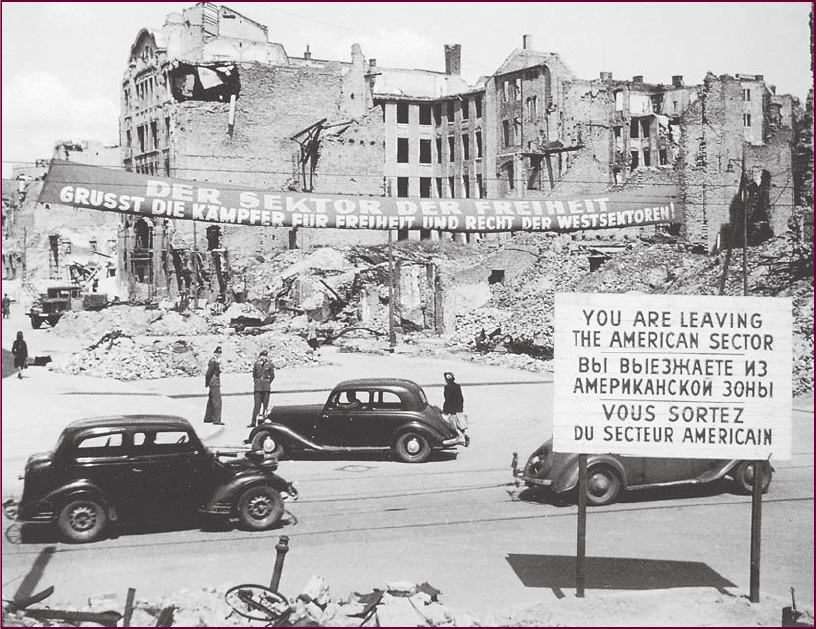
Assistance (COMECON) for economic cooperation. Then,
in 1955, Albania, Bulgaria, Czechoslo vakia, East Germany,
H ungary, P oland, Romania, and the Soviet Union orga-
nized a formal military alliance, the Warsaw P act. Once
again, Eur ope was tragically divided into hostile alliance
systems (see Map 26.1).
Who Started the Cold War? There has been consid-
erable historical debate over who bears responsibility for
starting the Cold War. In the 1950s, most scholars in the
West assumed that the bulk of the blame must fall on the
shoulders of Stalin, whose determination to impose So-
viet rule on Eastern Europe snuffed out hopes for free-
dom and self-determination there and aroused justifiable
fears of Communist expansion in the West. During the
next decade, however, revisionist historians---influenced
in part by aggressive U.S. policies in Southeast Asia---
began to argue that the fault lay primarily in Washington,
where Truman and his anti-Communist advisers aban-
doned the precepts of Yalta and sought to encircle the
Soviet Union with a tier of pliant U.S. client states.
Mor e recently, man y historians have adopted a more
nuanced view , observing that both the U nited States and the
Soviet U nion took some unwise steps at the end of World
War II. Both nations, however, were working within a
framework conditioned by the past. The rivalry between the
two superpowers ultimately stemmed from their different
historical perspectives an d their irreconcilable political
ambitions. Intense c ompetition for political and military
supremacy had long been a regular feature of Western
civilization. The U nited States and the Soviet Union were
the heirs of that Eur opean tradition of power politics, and it
should not surprise us that two such different systems
would seek to extend their way of life to the rest of the
world. Because of its need to secure its western border, the
Soviet U nion was not prepared to give up the advantages it
had gained in Eastern Europe from Germany’s defeat. But
neither were Western leaders prepared to accept without
protest the establishment of a system of Soviet satellites that
not only threatened the security of Western Europe but also
deeply offended Western sensibilities because of its blatant
disregard of the Western concept of human rights.
A City Divided. In 1948, U.S. planes airlifted supplies into Berlin to break the blockade that Soviet troops
had imposed to isolate the city. Shown here is ‘‘Checkpoint Charlie,’’ located at the boundary between the U.S.
and Soviet zones of Berlin, just as Soviet roadblocks are about to be removed. The banner at the entrance to
the Soviet sector reads, ironically, ‘‘The sector of freedom greets the fighters for freedom and right of the
Western sectors.’’
c
Keystone/Getty Images
THE COLLAPSE OF THE GRAND ALLIANCE 649
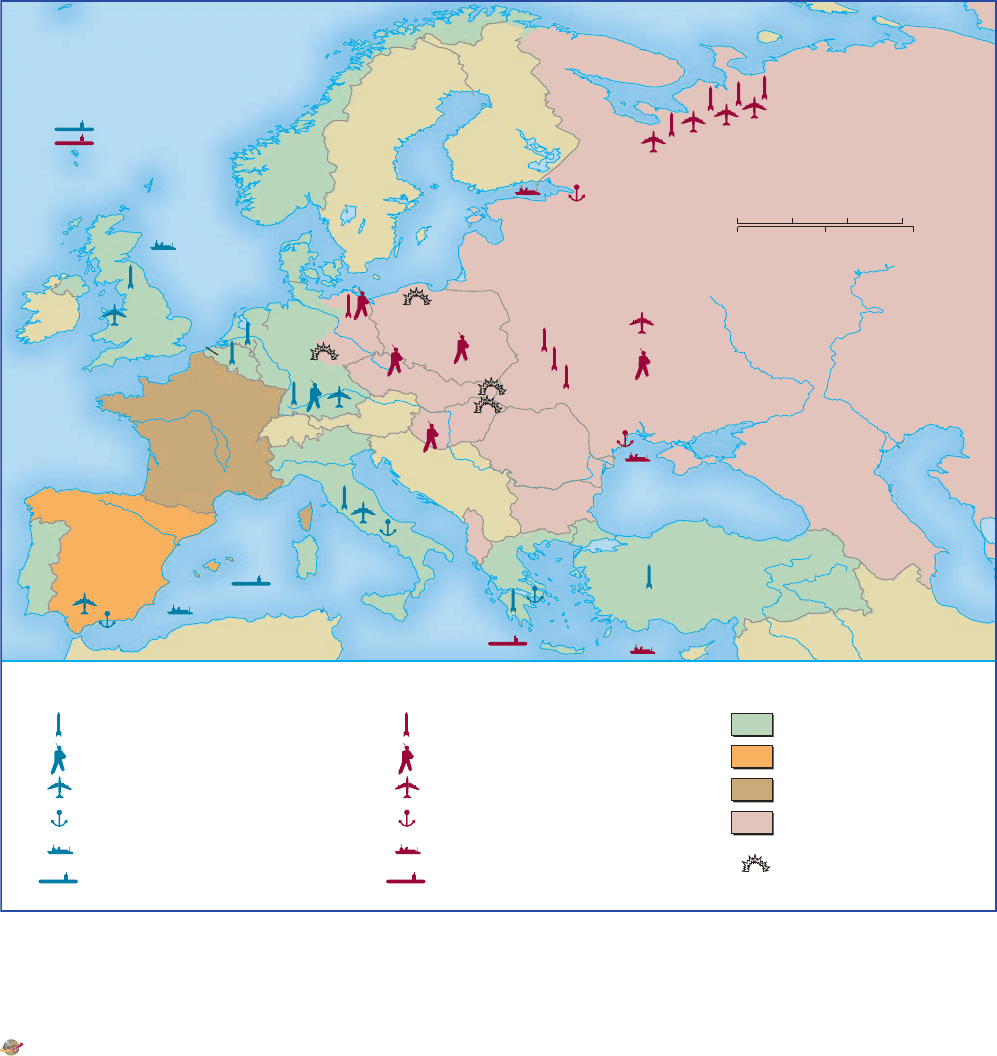
This does not necessarily mean that both sides bear
equal responsibility for starting the Cold War . Some revi-
sionist historians have claimed that the U.S. doctrine
of containment was a prov ocative action that aroused
Stalin’ s suspicions and drove Moscow into a position of
hostility towar d the West. This charge lacks credibility. As
information from the Soviet archives and other sources has
become available, it is increasingly clear that Stalin’s sus-
picions of the West were rooted in his Marxist-Leninist
worldview and long predated Washington ’s enunciation
of the doctrine of containment. As his foreign minister ,
Vyacheslav Molotov, once remarked, Soviet policy was
B
a
l
e
a
r
i
c
I
s
l
a
n
d
s
Corsica
Sardinia
Cyprus
E
b
r
o
R
.
E
u
p
h
r
a
t
e
s
T
i
g
r
i
s
R.
Y
U
G
O
S
L
A
V
I
A
SWITZ.
BULGARIA
ROMANIA
FRANCE
SPAIN
PORTUGAL
ITALY
ALBANIA
BELG.
IRELAND
GREECE
GREAT
BRITAIN
C
a
s
p
i
a
n
S
e
a
M
e
d
i
t
e
r
r
a
n
e
a
n
S
e
a
Sicily
Crete
D
a
n
u
b
e
C
Z
E
C
H
O
S
L
O
V
A
K
IA
GER.
DEM.
REP.
TURKEY
R.
NORWAY
SWEDEN
HUNGARY
NETH.
DENMARK
FINLAND
AUSTRIA
FED.
REP.
OF
GER.
North
Sea
Atlantic
Ocean
Black Sea
SOVIET UNION
R
h
i
n
e
R
.
B
a
l
t
i
c
S
e
a
Arctic Ocean
POLAND
V
o
l
g
a
R
.
R.
0 300 600 Miles
0 300 600 900 Kilometers
NATO member
Non-NATO ally
NATO member until 1959
Warsaw Pact member
Unrest/revolt in
Eastern Europe
Missile bases: NATO
Troops: U.S.
Nuclear bombers: U.S.
Naval port: U.S.
Fleet: U.S.
Nuclear missile submarine: U.S.
United States/NATO
Missile bases: Warsaw Pact
Troops: Soviet
Nuclear bombers: Soviet
Naval port: Soviet
Fleet: Soviet
Nuclear missile submarine: Soviet
Soviet Union/Warsaw Pact
MAP 26.1 The New Europe an A lliance Systems During the Cold War. This map shows
postwar Europe as it was divided during the Cold War into two contending power blocs, the
NATO alliance and the Warsaw Pact. Major military and naval bases are indicated by symbols
on the map.
Q
Whereonthemapwastheso-calledironcurtain?
View an animated version of this map or related maps at www.cengage.c om/history/
duikspiel/essentialworld6e
650 CHAPTER 26 EAST AND WEST IN THE GRIP OF THE COLD WAR

inherently aggressive and would be triggered whenever the
opportunity offered. Although Stalin apparently had no
master plan to advance Soviet power into Western Europe,
he was probably prepar ed to make every effort to do so
once the next revolutionary wave arrived. Western leaders
were fully justified in reacting to this possibility by
strengthening their own lines of defense. On the other
hand, a case can be made that in deciding to respond to
the Soviet challenge in a primarily military manner,
Western leaders overreacted to the situation and virtually
guaranteed that the Cold War would be transformed into
an arms race that could conceivably result in a new and
uniquely destructive war.
Cold War in Asia
Q
Focus Question: How and why did Mao Zedong and
the Communists come to power in China, and what
were the Cold War implicati ons of their triumph?
The Cold War was somewhat slower to make its appear-
ance in Asia. At Yalta, Stalin formally agreed to enter the
P acific War against Japan three months after the close of
the conflict with Germany. As a reward for Soviet partic-
ipation in the struggle against Japan, Roosevelt promised
that Moscow would be granted ‘‘preeminent interests’’ in
Manchuria (interests reminiscent of those possessed by
imperial Russia prior to its defeat at the hands of Japan in
1904--1905) and the establishment of a Soviet naval base at
Port Arthur. In return, Stalin promised to sign a treaty of
alliance with the Republic of China, thus implicitly
committing the Soviet Union not to provide the Chinese
Communists with support in a possible future civil war.
Although many observers would later question Stalin’s
sincerity in making such a commitment to the vocally
anti-Communist Chiang Kai-shek, in Moscow the deci-
sion probably had a logic of its own. Stalin had no par-
ticular liking for the independent-minded Mao Zedong
and indeed did not anticipate a Communist victory in any
civil war in China. Only an agreement with Chiang could
provide the Soviet Union with a strategically vital eco-
nomic and political presence in northern China.
The Truman administration was equally reluctant to
get embroiled in a confrontation with Moscow over the
unfolding events in East Asia. Suspicion of Chiang Kai-
shek ran high in Washington, and as we shall see, many
key U.S. policymakers hoped to avoid a deeper involve-
ment in China by brokering a compromise agreement
between Chiang and his Communist rival, Mao.
Despite these commitments, the Allied agr eements
soon broke down, and East Asia was sucked into the vortex
of the Cold War by the end of the 1940s. The root of the
problem lay in the underlying weakness of Chiang’s regime,
which threatened to create a political vacuum in East Asia
that both M osco w and Washington would be tempted to fill.
The Chinese Civil War
As World War II came to an end in the Pacific, relations
between the government of Chiang Kai-shek in China and
its powerful U.S. ally had become frayed. Although Roo-
sevelt had hoped that Republican China would
be the keystone of his plan for peace and stability in Asia
after the war, U.S. officials became disillusioned with the
corruption of Chiang’s government and his unwill-
ingness to risk his forces against the Japanese (he hoped to
save them for use against the Communists after the war in
the Pacific ended), and China was no longer the focus of
Washington’s close attention as the war came to a close.
Nevertheless, U.S. military and economic aid to China
had been substantial, and at war’s end, the new Truman
administration still hoped that it could rely on Chiang to
support U.S. postwar goals in the region.
While Chiang Kai-shek wrestled with Japanese ag-
gression and problems of national development, the
Communists were building up their strength in northern
China. To enlarge their political base, they carried out a
‘‘mass line’’ policy (from the masses to the masses), re-
ducing land rents and confiscating the lands of wealthy
landlords. By the end of World War II, 20 to 30 million
Chinese were living under the administration of the
Communists, and their People’s Liberation Army (PLA)
included nearly one million troops.
As the war came to an end, world attention began to
focus on the prospects for renewed civil strife in China.
Members of a U.S. liaison team stationed in Yan’an were
impressed by the performance of the Communists, and
some recommended that the United States should support
them or at least remain neutral in a possible conflict
between Communists and N ationalists for contr ol of
China. The Truman administration, though skeptical of
Chiang’s ability to forge a strong and prosper ous country,
was increasingly concerned about the spread of commu-
nism in Euro pe and tried to find a peaceful solution
through the formation of a coalition government of all
parties in China.
The Communist Triumph The effort failed. By 1946, full-
scale war between the N ationalist government, now re-
installed in N anjing, and the Communists resumed. N ow
Chiang K ai-shek ’s errors came home to roost. In the
countryside, millions of peasants, attracted to the Com-
munists by promises of land and social justice, flocked to
serve in Mao Zedong’s PLA. In the cities, middle-class
Chinese, normally hostile to communism, were alienated by
COLD WAR IN ASIA 651
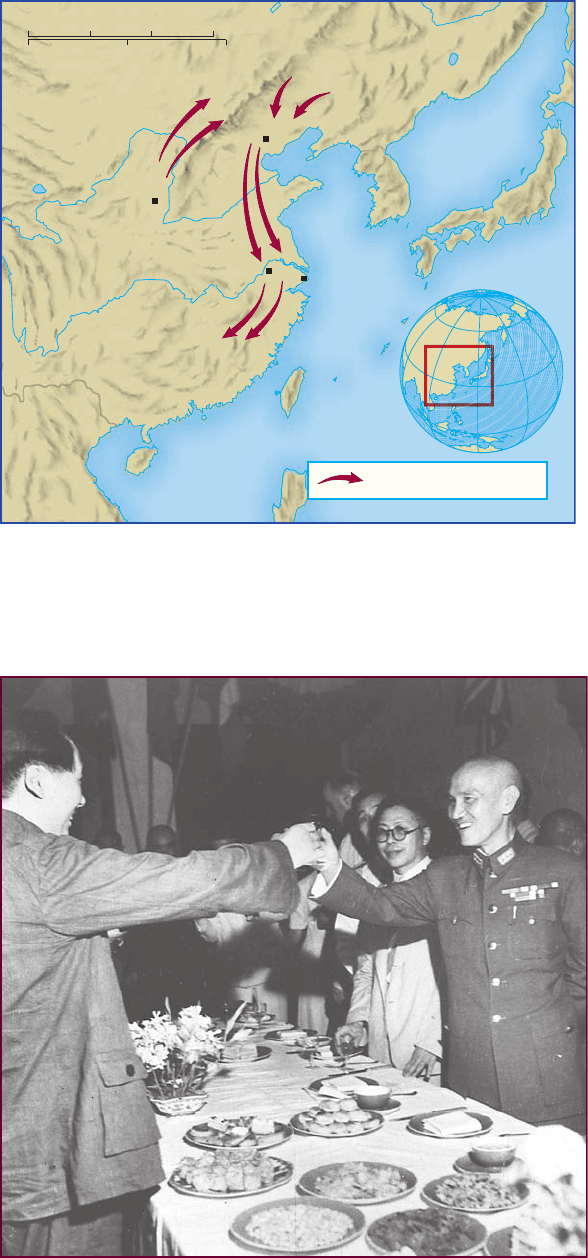
Chiang’s brutal suppression of all dissent and
his government’s inability to slow the ruinous
rate of inflation or solve the economic problems
it caused. W ith morale dropping in the cities,
Chiang’s troops began to defect to the Com-
munists. Sometimes whole divisions, officers as
well as ordinary soldiers, changed sides. By
1948, the PLA was advancing south out of
Manchuria and had encircled Beijing. Com-
munist troops took the old imperial capital,
crossed the Yangtze the following spring, and
occupied the commer cial hub of Shanghai (see
Map 26.2). During the next few months,
Chiang’s government and two million of his
followers fled to Taiwan, which the Japanese
had returned to Chinese control after World
War II.
The Truman administration reacted to the
spread of Communist power in China with
acute discomfort. Washington had no desire to
see a Communist government on the main-
land, but it had little confidence in Chiang
Kai-shek’s ability to realize Roosevelt’s dream
of a strong, united, and prosperous China. In
December 1945, President Truman sent Gen-
eral George C. Marshall to China in a last-
ditch effort to bring about a peaceful settle-
ment, but anti-Communist elements in the
Republic of China resisted U.S. pressure to
create a coalition government with the Chi-
nese Communist Party (CCP). During the
next two years, the United States gave limited
military support to Chiang ’s regime but re-
fusedtocommitU.S.powertoguaranteeits
survival. The administration’s hands-off policy
deeply angered man y members of Congress,
who charged that the White House was ‘‘soft
on communism’’ and declared further that
Roosevelt had betrayed Chiang Kai-shek at
Yalta by granting privileges in Manchuria to
the Soviet Union. In their view, Soviet troops
had hindered the dispatch of Chiang’s forces
to the area and provided the PLA with weap-
ons to use against its rivals.
MONGOLIA
TAIWAN
CHINA
MANCHURIA
JAPAN
KOREA
South
China
Sea
Pacific
Ocean
Sea of Japan
(East Sea)
Y
a
n
g
t
z
e
R
.
Y
e
l
l
o
w
R
.
Shanghai
Nanjing
Beijing
Yan’an
Route of PLA advance
0 500 1,000 Miles
0 250 500 750 Kilometers
MAP 26.2 The Chinese Civil War. After the close of th e Pacific War
in 1945, the Nationalist Chinese government and the Chinese Communists
fought a bitter civil war that ended with a victory by the latter in 1949.
The path of the Communist advance is displayed on the map.
Q
Wher e did Chiang Kai-shek ’s government retreat to after its defeat?
c
Jack Wilkes/Time Life Pictures/Getty Images
Mao Zedong and Chiang Kai-shek Exchange a
Toast. After World War II, the United States sent General
George C. Marshall to China in an effort to prevent civil
war between Chiang Kai-shek’s government and Mao
Zedong’s Communists. Marshall’s initial success was
symbolized by this toast between Mao (at the left) and
Chiang. But suspicion ran too deep, and soon conflict
ensued, leading to a Communist victory in 1949. Chiang’s
government retreated to the island of Taiwan.
652 CHAPTER 26 EAST AND WEST IN THE GRIP OF THE COLD WAR

In later years, sources in both Moscow and Beijing
indicated that the Soviet Union gave little assistance to
the CCP in its struggle against the Nanjing regime. In fact,
Stalin periodically advised Mao against undertaking the
effort. Although Communist forces undoubtedly received
some assistance from Soviet occupation troops in Man-
churia, their victory ultimately stemmed from conditions
inside China, not from the intervention of outside pow-
ers. So indeed argued the Truman administration in 1949,
when it issued a White Paper that placed most of the
blame for the debacle at the feet of Chiang Kai-shek’s
regime (see the box above).
Many Americans, however, did not agree. With the
Communist victory, Asia became a theater of the Cold
War and an integral element of American politics. During
the spring of 1950, under pressure from Congress and
public opinion to define U.S. interests in Asia, the Tru-
man administration adopted a new national security
policy, known as NSC-68, that implied that the United
States would take whatever steps were necessary to stem
the further expansion of communism in the region.
Containment had come to East Asia.
The New China
Communist leaders in China, from their new capital of
Beijing, probably hoped that their accession to power in
1949 would bring about an era of peace in the region and
permit their new government to concentrate on domestic
goals. But the desire for peace was tempered by their
determination to erase a century of humiliation at the
hands of imperialist powers and to restore the traditional
WHO LOST CHINA?
In 1949, with China about to fall under the control
of the Communists, President Truman instructed
the State Department to prepare a White Paper
explaining why the U.S. policy of seeking to avoid a
Communist victory in China had failed. The authors of the paper
concluded that responsibility lay at the door of Nationalist Chi-
nese leader Chiang Kai-shek and that there was nothing the
United States could have done to alter the result. Most China
observers today would accept that assessment, but it did little
at the time to deflect criticism of the administration for selling
out the interests of our ally in China.
U.S. State Department White Paper on China, 1949
When peace came the United States was confronted with three pos-
sible alternatives in China: (1) it could have pulled out lock, stock,
and barrel; (2) it could have intervened militarily on a major scale
to assist the Nationalists to destroy the Communists; (3) it could,
while assisting the Nationalists to assert their authority over as
much of China as possible, endeavor to avoid a civil war by working
for a compromise between the two sides.
The first alternative would, and I believe American public opin-
ion at the time so felt, have represented an abandonment of our
international responsibilities and of our traditional policy of
friendship for China before we had made a determined effort to
be of assistance. The second alternative policy, while it may look
attractive theoretically, in retrospect, was wholly impracticable. The
Nationalists had been unable to destroy the Communists during
the ten years before the war. Now after the war the Nationalists
were ...weakened, demoralized, and unpopular. They had quickly
dissipated their popular suppor t and prestige in the areas liberated
from the Japanese by the conduct of their civil and military officials.
The Communists on the other hand were much stronger than they
had ever been and were in control of most of North China. Because
of the ineffectiveness of the Nationalist forces, which was later to be
tragically demonstrated, the Communists probably could have been
dislodged only by American arms. It is obvious that the American
people would not have sanctioned such a colossal commitment of
our armies in 1945 or later. We therefore came to the third alterna-
tive policy whereunder we faced the facts of the situation and
attempted to assist in working out a modus vivendi which would
avert civil war but nevertheless preserve and even increase the influ-
ence of the National Government. ...
The distrust of the leaders of both the Nationalist and Commu-
nist Parties for each other proved too deep-seated to permit final
agreement, notwithstanding temporary truces and apparently prom-
ising negotiations. The Nationalists, furthermore, embarked in 1946
on an overambitious military campaign in the face of warnings by
General Marshall that it not only would fail but would plunge
China into economic chaos and eventually destroy the National
Government. ...
The unfortunate but inescapable fact is that the ominous result
of the civil war in China was beyond the control of the government
of the United States. Nothing that this country did or could have
done within the reasonable limits of its capabilities could have
changed that result; nothing that was left undone by this countr y
has contributed to it. It was the product of internal Chinese forces,
forces which this country tried to influence but could not. A deci-
sion was arrived at within China, if only a decision by default.
Q
How did the authors of the White Paper explain the
Communist victory in China? According to this argument, what
actions might have prevented it?
COLD WAR IN ASIA 653
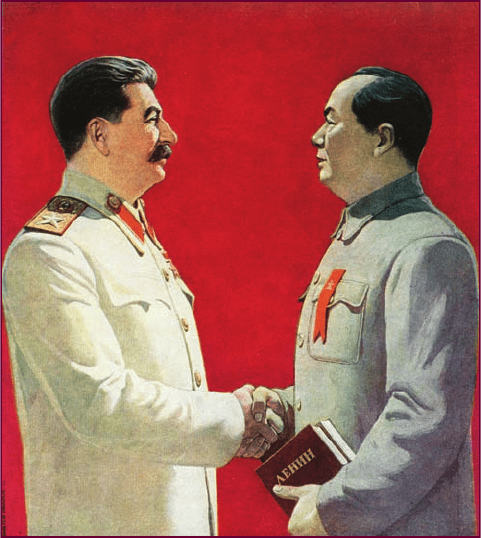
outer frontiers of the empire. In addition to recovering
territories that had been part of the Manchu Empire, such
as Manchuria, Taiwan, and Tibet, the Chinese leaders also
hoped to restore Chinese influence in former tributary
areas such as Korea and Vietnam.
It soon became clear that these two goals were not
always compatible. Negotiations between Mao and Stalin,
held in Moscow in January 1950, led to Soviet recognition
of Chinese sovereignty over Manchuria and Xinjiang (the
desolate lands north of Tibet that were known as Chinese
Turkestan because many of the peoples in the area were of
Turkic origin), although the Soviets retained a measure of
economic influence in both areas. Chinese troops occu-
pied Tibet in 1950 and brought it under Chinese
administration for the first time in more than a century.
But in Korea and Taiwan, China’s efforts to re-create the
imperial buffer zone provoked new conflicts with foreign
powers.
The problem of Taiwan was a consequence of the
Cold War. As the civil war in China came to an end, the
Truman administration appeared determined to avoid
entanglement in China’s internal affairs and indicated
that it would not seek to prevent a Communist takeover
of the island, now occupied by Chiang Kai-shek’s Re-
public of China. But as tensions between the United
States and the new Chinese government escalated during
the winter of 1949--1950, influential figures in the United
States began to argue that Taiwan was crucial to U.S.
defense strategy in the Pacific.
The Korean War
The outbreak of war in K or ea also helped bring the Cold
War to East Asia. After the Sino-Japanese War in 1894--
1895, Korea, long a Chinese tributary, had fallen increas-
ingly under the rival influences of J apan and Russia. After
the Japanese defeated the R ussians in 1905, Korea became
an integral part of the Japanese Empire and remained so
until 1945. The removal of Korea from Japanese control
had been one of the stated objectives of the Allies in World
War II, and on the eve of Japanese surrender in August
1945, the Soviet U nion and the United States agreed to
divide the country into two separate occupation zones at
the 38th parallel. They originally planned to hold national
elections after the restoration of peac e to reunify K or ea
under an independent gov ernment. But as U.S.-So viet re-
lations deteriorated, two separate governments emerged in
Korea, a Communist one in the north and an anti-Com-
munist one in the south.
Tensions between the two governments ran high
along the dividing line, and on June 25, 1950, with the
apparent approval of Stalin, North Korean troops invaded
the south. The Truman administration immediately or-
dered U.S. naval and air forces to support South Korea,
and the United Nations Security Council (with the Soviet
delegate absent to protest the UN’s refusal to assign
China’s seat to the new government in Beijing) passed a
resolution calling on member nations to jointly resist the
invasion, in line with the security provisions of the
United Nations Charter. By September, UN forces under
the command of U.S. General Douglas MacArthur
marched northward across the 38th parallel with the aim
of unifying Korea under a single, non-Communist
government.
President Truman worried that by approaching the
Chinese border at the Yalu River, the UN troops could
trigger Chinese intervention, but MacArthur assured him
that China would not respond. In November, however,
Chinese ‘‘volunteer’’ forces intervened in force on the side
of North Korea and drove the UN troops southward in
disarray. A static defense line was eventually established
near the original dividing line at the 38th parallel (see
Map 26.3), although the war continued.
To many Americans, the Chinese intervention in
Korea was clear evidence that China intended to promote
A Pled ge of Eternal Friendsh ip. After the Communist victory in
the Chinese civil war, Chairman Mao Zedong traveled to Moscow, where in
1950 he negotiated a treaty of friendship and cooperation with the Soviet
Union. The poster shown here trumpets the results of the meeting: ‘‘Long
live and strengthen the unbreakable friendship and cooperation of the
Soviet and Chinese peoples!’’ The two leaders, however, did not get along.
Mao reportedly complained to colleagues that obtaining assistance from
Stalin was ‘‘like taking meat from a tiger’s mouth.’’
c
Archives Charmet/ The Bridgeman Art Library
654 CHAPTER 26 EAST AND WEST IN THE GRIP OF THE COLD WAR
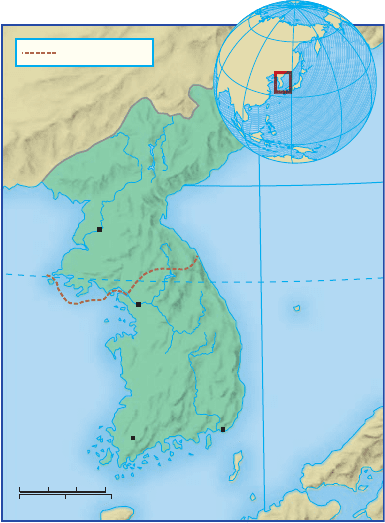
communism throughout Asia, and recent evidence sug-
gests that Mao was convinced that a revolutionary wave
was on the rise in Asia. In fact, however, China’s decision
to enter the war was probably motivated in large part by
the fear that hostile U.S. forces might be stationed on the
Chinese frontier and perhaps even launch an attack across
the border. MacArthur intensified such fears by calling
publicly for air attacks on Manchurian cities in prepa-
ration for an attack on Communist China.
In any case, the outbreak of the Korean War was
particularly unfortunate for China. Immediately after the
invasion, President Truman dispatched the U.S. Seventh
Fleet to the Taiwan Strait to prevent a possible Chinese
invasion of Taiwan. Even more unfortunate, the invasion
hardened Western attitudes against the new Chinese
government and led to China’s isolation from the major
capitalist powers for two decades. The United States
continued to support the Nationalist government in
Taiwan as the only legal representative of the Chinese
people and supported its occupation of China’s seat on
the UN Security Council. As a result, China was cut off
from all forms of economic and technological assistance
and was forced to rely almost entirely on the Soviet
Union, with which it had signed a pact of friendship and
cooperation in early 1950.
Conflict in Indochina
During the mid-1950s, China sought to build contacts
with the nonsocialist world. A cease-fire agreement
brought the Kor ean War to an end in July 1953, and China
signaled its desire to live in peaceful coexistence with other
independent countries in the region. But a relatively mi-
nor conflict now began to intensify on China’s southern
flank, in French Indochina. The struggle had begun after
World War II, when the Indochinese Communist Party led
by Ho Chi Minh (1890--1969), at the head of a multiparty
nationalist alliance called the Vietminh Front, seized
power in northern and central Vietnam after the surrender
of imperial Japan. After abortive negotiations between
Ho’s government and the returning French, war broke out
in December 1946. French forces occupied the cities and
the densely populated lowlands, while the Vietminh took
refuge in the mountains.
For three years, the Vietminh waged a ‘‘people’s war’’
of national liberation fr om colonial rule, gradually in-
creasing in size and effectiveness. At the time, however, the
conflict in Indochina attracted relatively little attention
from world leaders, who viewed the events there as only
one aspect of the transition to independence of colo-
nialized territories in postwar Asia. The Truman admin-
istration was uneasy about Ho’s longstanding credentials
as a Soviet agent but was equally reluctant to anger anti-
colonialist elements in the area by intervening on behalf of
the French. Moscow had even less interest in the region.
Stalin---still hoping to see the Communist Party come to
power in Paris---ignored Ho’s request for recognition of his
movement as the legitimate representative of the national
interests of the Vietnamese people.
Butwhathadbegunasananticolonialstruggleby
the Vietminh Front against the French became en-
tangled in the Cold War after the CCP came to power in
China. In early 1950, Beijing began to provide military
assistance to the Vietminh to burnish its revolutionary
credentials and protect its own borders from hostile
forces. The Truman administration, increasingly con-
cerned that a revolutionary ‘‘Red tide’’ was sweeping
through the region, decided to provide financial and
technical assistance to the French while pressuring them
to prepare for an eventual transition to independent
non-Communist governments in Vietnam, Laos, and
Cambodia.
With casualties mounting and the French public tired
of fighting the ‘‘dirty war’’ in Indochina, the French
agreed to a peace settlement with the Vietminh at the
Geneva Conference in 1954. Vietnam was temporarily
divided into a northern Communist half (known as the
Democratic Republic of Vietnam, or DRV) and a non-
Communist southern half based in Saigon (eventually to
Yellow
Sea
Korea
Bay
Sea of Japan
(East Sea)
JAPAN
3
8
t
h
P
a
r
a
l
l
e
l
Y
a
l
u
R
.
T
u
m
e
n
R
.
K
o
r
e
a
S
t
r
a
i
t
CHINA
Kwangju
Seoul
Pusan
Pyongyang
0 100 200 Miles
0 100 200 300 Kilometers
Cease-fire line
MAP 26.3 The Kor ean Peninsula. In June 1950, North
Korean forces crossed the 38th parallel in a sudden invasion of
the south. Shown here is the cease-fire line that brought an end
to the war in 1953.
Q
What is the importance of the Yalu River?
COLD WAR IN ASIA 655
